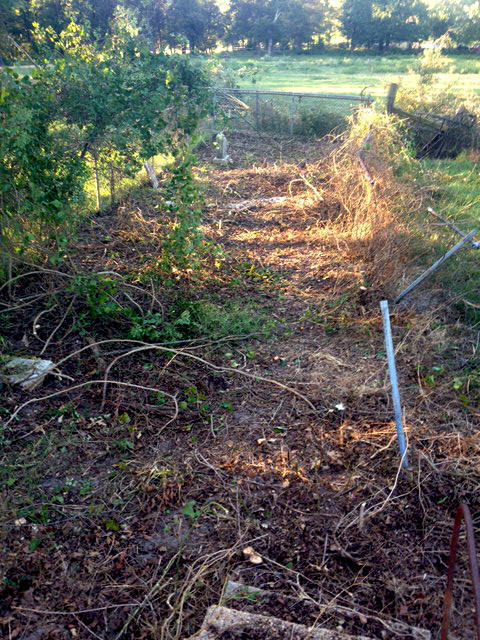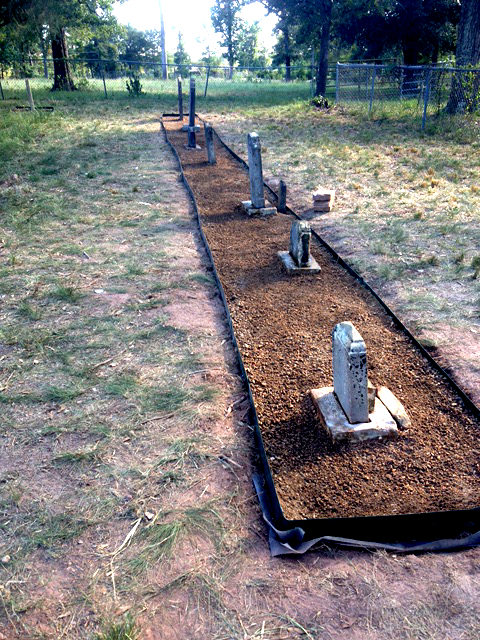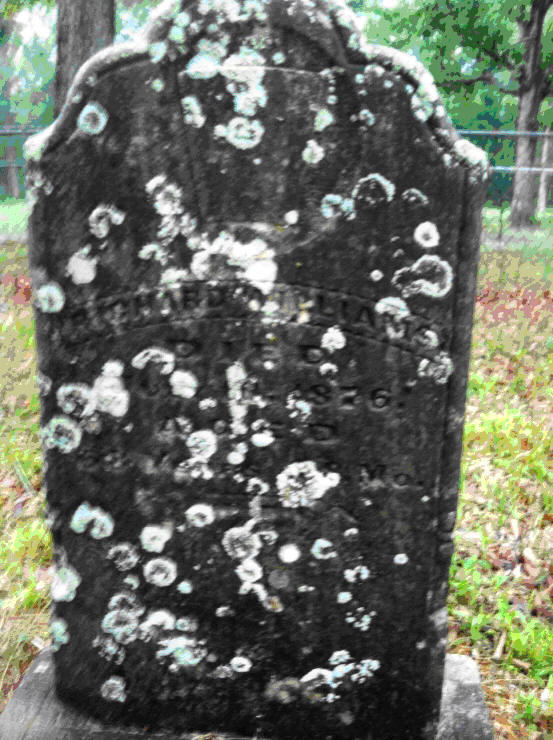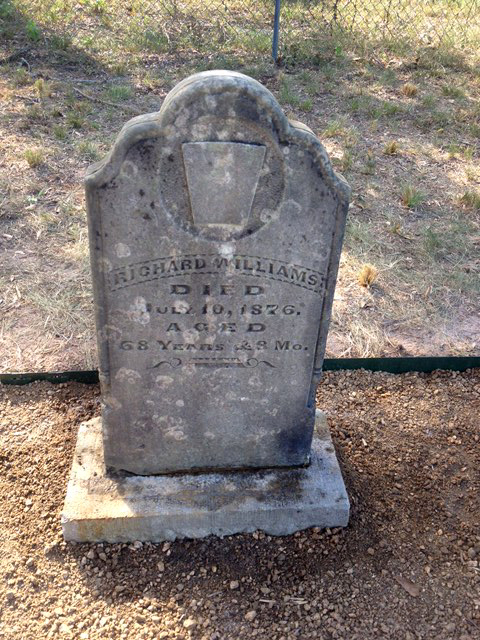|
Montgomery County Historical Commission Youth Advisory Board member,
Ross Ohendalski and fellow Youth Advisory Board (YAB) member Robert
Lynch (both seniors at Covenant Christian School), worked hard on
Saturday to clean the Carroll cemetery, located adjacent to the historic Richard
Williams cemetery east of Willis.

This small Carroll family cemetery has tombstones going back to the
1880's but has been overgrown with dense underbrush and small trees for
many years. As part of his Eagle boy scout project, Ross has planned
and organized the restoration of the Richard Williams cemetery and
tombstones.
Over the next few weekends, Ross will be heading up the project of
laying a crushed stone path to and round the Richard Williams family
tombstones, cleaning them and preserving them. I understand Covenant
Christian high school students have been invited to help. Also members
of the Historical Commission's Youth Advisory Board are invited to
assist.
For more information on the project, you are invited to contact Ross
Ohendalski at 936-697-4783 or rossoccs@yahoo.com.
Update on Eagle Scout Cleanup
Project of historic Richard Williams Family Cemetery
Larry
Foerster, Chairman
Montgomery County Historical Commission
September 20, 2015
Montgomery County Historical Commission's Youth Advisory Board (YAB)
member Ross Ohendalski is making great strides with his Eagle Scout
Project–the cleanup of the historic Richard Williams Cemetery east of
Willis.
With the help of fellow YAB members Robert Lynch and John Taylor, also
seniors at Covenant Christian High School, Ross has installed a granite
protective base path around the line of historic family cemetery
headstones and cleaned the headstones with a D2 stone cleaner. Ross
reports that they will return to complete the cleaning of the headstones
and other work to finish his Eagle Scout project.
By way of comparison, I thought you would like to see the Richard
Williams headstone BEFORE and AFTER cleaning with the D2 cleaner
designed for gentle removal of weather buildup and moss on old
headstones.
Richard Williams fought in the Texas Revolution in 1834-1835, served as
a captain in The Somerville Expedition to repel a invading Mexican army
in 1842, and served as a Montgomery County Commissioner about 1849. He
was also one of the signers of a petition in 1837 to create Montgomery
County.
Ross appreciates the financial support of the Chaparral Genealogical
Society in Magnolia, Richard Molk, and the Montgomery County Historical
Commission.

Richard Williams
Cemetery after Cleanup

Richard Williams
Tombstone before cleaning

Richard Williams
Tombstone after cleaning with D2 Cleaner
fffff
Photos of
Richard Williams and Carroll Cemetery Restoration for Montgomery
County Historical Commission by Ross Ohendlaski for his
Eagle Project October 2015
fffff
Short Biography of
Richard Williams
by Larry L. Foerster, Chairman
Montgomery County Historical Commission
April 22, 2012
Richard Williams
was born in February 1808 in Milledgeville, Baldwin County, Georgia to
the marriage of James Edward Williams and Nancy Hill. Williams arrived
in Texas in 1834 as a single man from Georgia to presumably find his
fortune in this new land. His life symbolizes the unsung volunteer
Texian soldier who helped Texas win its independence.
It appears that after Richard Williams
arrived in Texas in 1834 at the age of 26, he fought in several battles
of the Texas Revolution, including the “Bexar campaign” in 1835 at the
battle known as the “Grass Fight” where he was severely wounded by a
canister shot while serving in Captain John M. Bradley’s company. The
shot struck a pistol at his side (thus his life was saved.) He remained
nearby until the city of San Antonio was taken. His next term of
service was in the mop-up campaign subsequent to the Battle of San
Jacinto (April 21, 1836), after his marriage to Mary Miller in January
1836.
Richard Williams
married Mary Miller on January 26, 1836 in Washington County (now
Montgomery County), Texas. Mary Miller was the 3rd daughter
of James Miller (who was born in Tennessee in 1792 and died in Texas in
1830) and Ruth (“Ruthie”) Shannon, daughter of early Montgomery County
settlers Owen Shannon and wife Margaret A. Montgomery Shannon, who lived
northwest of what today is known as Dobbin.
It is reported that the Republic of
Texas gave Richard Williams a large tract of land for his service in the
War, and he and his wife Mary settled in the Washington Municipality
east of what would become the Danville community. He also reportedly
received land in Travis County. (Today this land is in northern
Montgomery County along the Walker county line.) He built a cabin near
the present site of the family cemetery on a hill in a grove of cedars
overlooking Peach Tree Creek, and he operated at various times a farm, a
sawmill, gristmill, and cotton gin.
It appears that Richard Williams and
his wife had settled on his land by late 1837, since he was one of
several citizen land owners in what was then Washington Municipality in
October 1837 to petition the Republic of Texas for a new county with the
Brazos River as the dividing line. The Act creating Montgomery County
was passed on December 14, 1837.
The Tax Rolls of Montgomery County in
1838 (as compiled by Mary Peoples) shows that in June 1838 Richard
Williams was listed as a property owner, but the rolls do not identify
how many acres he owned.
Richard Williams
and Mary Miller Williams reportedly had 13 children, only two of whom
are known to be buried at the Richard Williams Cemetery: Leila Jacinto
Williams (2nd child) died at age 3 on March 8, 1842, and Sam
Houston Williams (3rd child) died reportedly in 1852. [NOTE:
The Texas Historical Marker at the Cemetery identifies the Williams’ as
having only 10 children, that Leila Jacinto Williams was the 3rd
child, and that Sam Houston Williams died in 1852.]
In October 1842, soon after the death
of his young daughter Leila Jacinto Williams in August, then Captain
Richard Williams lead a Montgomery County volunteer militia for the
Somervell Expedition, organized by Alexander Somervell to invade Mexico
at President Sam Houston’s order. Along the way Williams became severely
ill and left the force before it reached Mexico, thereby avoiding the
fate of many of the men in the Expedition who were later captured and
killed by the Mexican army as part of the ill-fated Mier Expedition.
(One of the volunteers under Capt. Williams was William Henry Hulon,
husband of Phoebe Reese Spillers, daughter of John and Frances Conger
Spillers. Hulon was a farmer who raised his family of 7 children near
the Danville community and later at age 46 joined the Confederate
Danville Mounted Riflemen in May 1861.)
According to the Montgomery County
Commissioners’ Court Minutes in January 1845, the Court appointed
Richard Williams, along with John Park, Jonathan H. Ridgeway, A H White,
and Joseph Lindley, to mark and lay out a road commencing near Joseph
Lindley’s property, “running to Burches ferry on San Jacinto and make
report of their actings and doings at the next term of this Court.”
Montgomery County Commissioners Court
Minute Book records that Richard Williams was serving as Montgomery
County Commissioner by 1849. According to the October 15, 1850 Federal
census for Montgomery County, Richard Williams at age 42 owned property
valued at $5000 (a significant sum for that time), was married to Mary
(age 32) and had 7 living children ages 13 to 2 years. (Leila Jacinto
had died in 1842)
Stories from William’s descendants, as reported in the Conroe Courier
in February 27-28, 1972, describe an incident where he shot 3 Federal
soldiers after the Civil War as they were traveling across his property.
He claimed he mistook them for Indians. Legend has it that Williams
buried the three soldiers under his cabin where their ghosts continued
to haunt the place.
In the 1872 Texas Almanac,
Richard Williams was reported by J. H. Shepherd (himself one of the
Montgomery County veterans of the Texas Revolution) to be “about 60
years old…looks as young as twenty-five years ago;” and at times
suffered from his wound at the Grass Fight in 1835.
Richard Williams
died on October 10, 1876 at age 68, and was buried on his property in
the one-half acre family burial site alongside at least two of his
children: Leila Jacinto Williams and Sam Houston Williams. His wife Mary
Miller Williams died on November 9, 1894 and is buried next to her
husband. Part of the original Williams tract was purchased by Gene and
Christina Molk in 1952 where they operated a family dairy farm for many
years. The Williams burial site was largely neglected until about 1975
when the Montgomery County Historical Survey Committee fenced the site,
and a Texas Historical Marker was placed at the cemetery.

Richard Williams
Tombstone
There are reportedly 70 unmarked graves in the unfenced area of the
cemetery and there is a separate fenced but neglected area where members
of the Carroll family are buried, with markers dating back to the
1880’s. Gene and Christina Molk, along with their daughter, are also
buried in a separate section of the burial site, about 30 feet away from
the Williams family tombstones. (These tombstones are in relatively
good condition but desperately need to be cleaned.)
It is believed (but not yet confirmed)
that the 1842 tombstone of Richard Williams’ three-year old daughter,
Leila Jacinto Williams, is the oldest known legible tombstone in
Montgomery County.

Leila Jacinto Williams
Tombstone
The Richard Williams Cemetery is
located about 6 miles east of Willis off of FM 1097 East on private
property near the Montgomery-Walker county lines.
|

